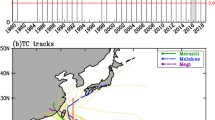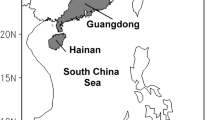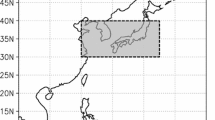Abstract
Four tropical cyclones (TCs) formed over the western North Pacific (WNP) basin and continuously made landfall on the coastal areas of the eastern China mainland during July–August in 2018 and caused significant damage to the coastwise areas. Such a continuous TC landfall event affecting adjacent regions within a short period has never happened in previous decades, and the landfall event was attributed to anomalous environments over the WNP. During July–August in 2018, the dynamic and thermodynamic conditions were favorable for increased TC genesis, which is a prerequisite for the continuous TC landfall. However, the low sea surface temperature and high outflow temperature prohibited further intensification of the four landfall TCs. More importantly, the northwestward shift of the subtropical high and stronger monsoonal circulation resulted in anomalous easterlies that steered the four TCs toward the coastline of East China. Further investigation indicates that an earlier La Niña event that occurred from late autumn in 2017 to early spring in 2018 may have played a key role during the period. The robust monsoon circulation and enhanced precipitation over the low-latitudinal regions of the WNP basin were induced by the earlier La Niña event and provided advantageous conditions for TC genesis and movement, thus leading to the continuous TC landfall event. Significant negative correlations are found between the summer monsoon activity and earlier El Niño Southern Oscillation (ENSO) events. After an earlier La Niña event, more TCs are expected to form during the following summer such as in the scenario in 2018 due to the vigorous monsoonal circulation, which provides favorable large-scale environments. In addition, the abnormal Hadley circulation, which may be associated with the earlier La Niña event, shifted the subtropical high northward and resulted in the anomalous easterlies that steered the TCs toward East China.










Similar content being viewed by others
References
Camargo SJ, Sobel AH (2005) Western North Pacific tropical cyclone intensity and ENSO. Clim 18:2996–3006
Camargo SJ, Emanuel K, Sobel AH (2007) Use of a genesis potential index to diagnose ENSO effects on tropical cyclone genesis. J Clim 20(19):4819–4834
Chan JCL (1985) Tropical cyclone activity in the northwest Pacific in relation to the El Niño/Southern oscillation phenomenon. Mon Weather Rev 113:599–606
Chan JCL (2000) Tropical cyclone activity over the western North Pacific associated with El Niño and La Niña Events. J Clim 13:2960–2972
Chan JCL (2006) Comment on “Changes in tropical cyclone number, duration, and intensity in a warming environment”. Science 311(5768):1713
Chan JCL, Gray WM (1982) Tropical cyclone movement and surrounding flow relationship. Mon Weather Rev 110(10):1354–1374
Chen G, Tam CY (2010) Different impacts of two kinds of Pacific Ocean warming on tropical cyclone frequency over the western North Pacific. Geophys Res Lett 37(1)
Chen X, Wu L, Zhang J (2011) Increasing duration of tropical cyclones over China. Geophys Res Lett 38(2):L02708. https://doi.org/10.1029/2010gl046137
Dvorak VF (1975) Tropical cyclone intensity analysis and forecasting from satellite imagery. Mon Weather Rev 103(5):420–430
Emanuel K (1987) The dependence of hurricane intensity on climate. Nature 326(6112):483–485
Emanuel K (1995) Sensitivity of tropical cyclones to surface exchange coefficients and a revised steady-state model incorporating eye dynamic. J Atmos Sci 52(22):3969–3976
Emanuel K (1997) Some aspects of hurricane inner-core dynamics and energetics. J Atmos Sci 54(8):1014–1026
Emanuel K (2005) Increasing destructiveness of tropical cyclonesover the past 30 years. Nature 436:686–688
Emanuel K (2007) Environmental factors affecting tropical cyclonepower dissipation. J Clim 20:5497–5509
Emanuel K, Nolan DS (2004) Tropical cyclone activity and the global climate system. 26th Conference on Hurricanes and Tropical Meteorology
Fiorino M, Elsberry RL (1989) Contribution to tropical cyclone motion by small, medium and large scales in the initial vortex. Mon Weather Rev 117(4):721–727
Gall JS, Frank WM (2010) The role of equatorial Rossby waves in tropical cyclogenesis. Part II: idealized simulations in a monsoon trough environment. Mon Weather Rev 138(4):1383–1398
Gong DY, Ho CH (2002) Shift in the summer rainfall over the Yangtze River valley in the late 1970s. Geophys Res Lett 29(10):78-1
Gray WM (1968) Global view of the origin of tropical disturbances and storms. Mon Weather Rev 96:669–700
Gray WM (1979) Hurricanes: their formation, structures, and likely role in the tropical circutlation. Meoteorol Over Trop Ocean 155–218
Gray WM (1998) The formation of tropical cyclones. Meteorol Atmos Phys 67:37–69
Ho CH, Baik JJ, Kim JH, Gong DY, Sui CH (2004) Interdecadal changes in summertime typhoon tracks. J Clim 17:1767–1776
Holland GJ (1983) Tropical cyclone motion: environmental interaction plus a beta effect. J Atmos Sci 40(2):328–342
Holton JR (1992) An introduction to dynamic meteorology, 3d edn. Academic Press, Cambridge
Huang R, Wu Y (1989) The influence of ENSO on the summer climate change in China and its mechanism. Adv Atmos Sci 6(1):21–32
Lander MA (1994) An exploratory analysis of the relationship between tropical strom formation in the western North Pacific and ENSO. Mon Weather Rev 122(4):636–651
Landsea CW (2006) Can we detect trends in extreme tropical cyclones? Science 313:452–454
Li X, Wang B (1994) Barotropical dynamics of the beta gyres and beta drift. J Atmos Sci 51(5):746–756
Mei W, Xie SP (2016) Intensification of landfalling typhoons over the northwest Pacific since the late 1970s. Nat Geosci 9(10):753–757
Wang C (2002) Atmospheric circulation cells associated with the El Niño-southern oscillation. J Clim 15(4):399–419
Wang B, Chan JCL (2002) How strong ENSO events affect tropical storm activity over the western North Pacific. J Clim 15(13):1643–1658
Wang B, Fan Z (1999) Choice of South Asian summer monsoon indices. Bull Am Meteorol 80(4):629–638
Wang Y, Holland GJ (1996a) The beta drift of baroclinic vortices. Part I: adiabatic vortices. J Atmos Sci 53(3):411–427
Wang Y, Holland GJ (1996b) The beta drift of baroclinic vortices. Part II: Diabatic vortices. J Atmos Sci 53(24):3737–3756
Wang B, Zhang Q (2002) Pacific-east Asian teleconnection: part II: How the Philippine Sea anomalous anticyclone is established during El Niño development. J Clim 15(22):3252–3265
Wang B, Wu R, Fu X (2000) Pacific-east Asian teleconnection: how does ENSO affect East Asian climate? J Clim 13(9):1517–1536
Wang B, Wu R, Lao KM (2001) Interannual variability of the Asian summer monsoon: contrasts between the Indian and the western North Pacific-East Asian monsoons. J Clim 14(20):4073–4090
Wang B, Wu R, Li T (2003) Atmosphere-warm ocean interaction and its impacts on Asian–Australian monsoon variationi. J Clim 16:1195–1211
Wang C, Li C, Mu M, Duan W (2013) Seasonal modulations of different impacts of two types of ENSO events on tropical cyclone activity in the western North Pacific. Clim Dyn 40:2887–2902
Wang C, Wu L, Zhao H, Cao J, Tian W (2019) Is there a quiescent typhoon season over the western North Pacific following a strong El Niño event? Int J Climatol 39:61–73
Webster PJ, Holland GJ, Curry JA, Chang HR (2005) Changes in tropical cyclone number, duration, and intensity in a warming environment. Science 309:1844–1846
Wu L, Wang B (2004) Assessing impacts of global warming ontropical cyclone tracks. J Clim 17:1686–1698
Wu L, Wang B (2008) What changed the proportion of intensehurricanes in the last 30 years? J Clim 21:1434–1441
Wu L, Wang C (2015) Has the western Pacific subtropical high extended westward since the late 1970s. J Clim 28(13):5406–5413
Wu L, Zhao H (2012) Dynamically derived tropical cyclone intensity changes over the Western North Pacific. J Clim 25(1):89–98
Wu MC, Chang WL, Leung WM (2004) Impacts of El Niño and Southern Oscillation events on tropical cyclone landfalling activity in the western North Pacific. J Clim 17(6):1419–1428
Wu L, Wang B, Geng S (2005) Growing influence of typhoon on EastAsia. Geophys Res Lett 32:L18703. https://doi.org/10.1029/2005gl022937
Wu L, Chen X, Wu CC (2016) Revisiting the steering principal of tropical cyclone motion in a munerical experiment. Atmos Chem Phys 16(23):14925
Zeng Z, Wang Y, Wu CC (2007) Environmental dynamical control of tropical cyclone intensity—an observational study. Mon Weather Rev 135(1):38–59
Zhang Q, Wu L, Liu Q (2009) Tropical cyclone damages in China 1983–2006. Bull Am Meteorol Soc 90:489–495
Zhao H (2016) A downscaling technique to simulate changes in western North Pacific tropical cyclone activity between two types of El Niño events. Theoret Appl Climatol 123(3–4):1–15
Zhao H, Wu L (2014) Inter-decadal shift of the prevailing tropical cyclone tracks over the western North Pacific and its mechanism study. Meteorol Atmos Phys 125(1–2):89–101
Zhao J, Wu L, Zhao H (2012) Improvement of tropical cyclone genesis potential index in the western North Pacific basin (in Chinese). J Meteorol Sci 32(6):591–599
Zhao H, Wu L, Wang R (2014) Decadal variations of intense tropical cyclones over the Western North Pacific during 1948–2010. Adv Atmos Sci 31(1):57–65
Zhou T, Yu R, Zhang J et al (2009) Why the western Pacific subtropical high has extended westward since the late 1970s. J Clim 22(8):2199–2215
Zong H, Wu L (2015) Re-examination of tropical cyclone formation in monsoon troughs over the western North Pacific. 32(7):924–934
Acknowledgements
The authors are grateful to two anonymous reviewers for their perceptive comments that improved this paper. This research was jointly supported by the Natural Science Foundation of Jiangsu Province (BK20161074, BK20171095), the Young Scientists Found of the National Natural Science Foundation of China (41605032) and the Science and Technology Innovation Team of the Marine Weather Forecasting from the Jiangsu Meteorological Bureau.
Author information
Authors and Affiliations
Corresponding author
Additional information
Responsible Editor: A.-P. Dimri.
Publisher's Note
Springer Nature remains neutral with regard to jurisdictional claims in published maps and institutional affiliations.
Rights and permissions
About this article
Cite this article
Chen, X., Li, C., Liu, Y. et al. Possible influences of a La Niña event on a continuous tropical cyclone landfall event in east China. Meteorol Atmos Phys 132, 547–558 (2020). https://doi.org/10.1007/s00703-019-00708-2
Received:
Accepted:
Published:
Issue Date:
DOI: https://doi.org/10.1007/s00703-019-00708-2




